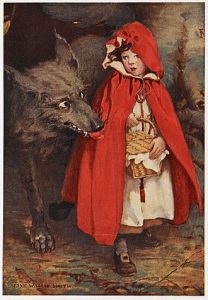17 Little Red Riding Hood: A Critical Theory Approach
Octaviano Gutierrez

Summary
The following document explores seven different interpretations of “Little Red Riding Hood” based on six different schools of literary critical theory and a baseline:
- Pre-critical – this is the baseline, surface-level interpretation of a given text.
- Formalist – focuses on literary devices and the structural purposes of word choice and phrasing.
- Archetypal / Jungian – focuses on archetypes or tropes in characters and symbols and how these interact with Jung’s idea of the collective unconsciousness.
- Psychological / Freudian – focuses on the relationship between Freud’s Id, Ego, and Superego, as well as the impact of dreams, phallic imagery, and representations of the Oedipus complex.
- Feminist – analyzes gender dynamics and representations of patriarchy, and how genders are defined and obectified or “othered.”
- Marxist – focuses on class conflict between a dominant class and a subjected class, particularly where ideologies of work as human value come into play.
- Historical – focuses on the connection or relationship between the text and the author’s life and/or the events happening around the time it was written.
Jenna Gardner
You can read the full text here: “Little Red Riding Hood: A Critical Theory Approach by Jenna Gardner” [Full Text].
Text Attributions
- “Little Red Riding Hood: A Critical Theory Approach” was written and created by Jenna Gardner.
